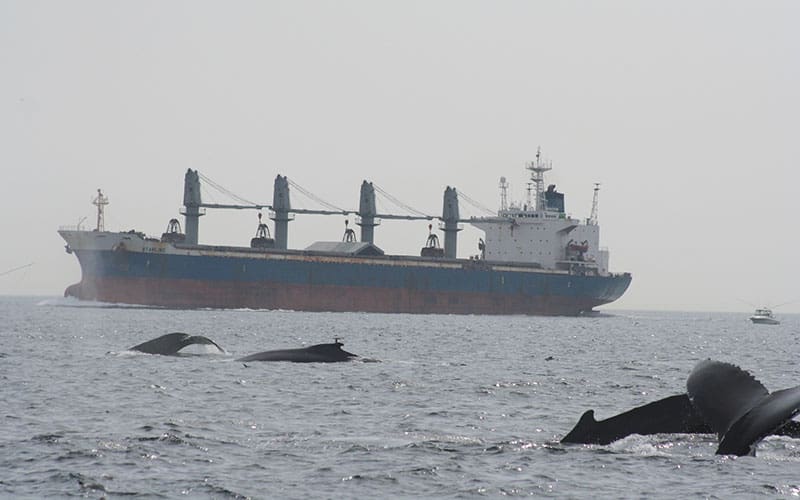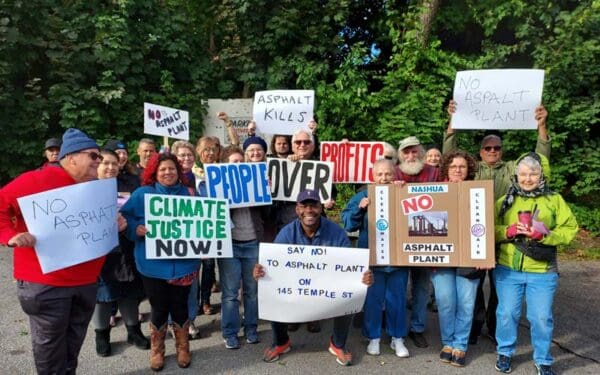
Allowing excessive boat traffic in the Sanctuary will harm precious marine life, including endangered whales. Photo taken under NOAA permit #981-1707
Stellwagen Bank National Marine Sanctuary just issued its final management plan and missed a golden opportunity to restore and protect one of the most remarkable places in New England’s ocean. Endangered whales and dozens of species of fish swim along its shallow banks and boulder reefs. Shipwrecks scattered along its seafloor are remarkable time capsules and home to myriad species, from sea anemones to sea stars.
More than 30 years ago, the federal government recognized this incredible ecosystem as a national marine sanctuary. But in the decades since, it has become a sanctuary in name only. Commercial and recreational fishing occurs throughout Stellwagen Bank, degrading seafloor habitat, impacting nearly every historic shipwreck within its boundaries, and depleting already overfished populations of Atlantic cod. Shipping lanes run through the Sanctuary — akin to putting a noisy highway through a national park. Climate change is also taking a toll on Stellwagen Bank, as the Gulf of Maine is warming faster than 97% of the world’s ocean waters. A 2020 government report shows that, despite its sanctuary status, Stellwagen’s health in many respects is getting worse, not better.
Now, because of agency inaction, Stellwagen Bank faces many more years of degradation. In a just-released management plan for the Sanctuary – the first update in thirteen years despite a requirement to review and update sanctuary management plans every five years – NOAA passed up an opportunity for bold new measures to protect this special place and traded it for an ineffective research, monitoring and education approach.
The new management plan ignores NOAA’s own report about Stellwagen’s depleted resources and degraded habitat. It ignores three years of public input into reasonable measures to strengthen Stellwagen’s safeguards. And it ignores the Biden administration’s conservation vision that emphasizes the need to protect more of our ocean to stem the tide of species loss and build its resilience to climate change.
Here’s a closer look at how the management plan fails Stellwagen and the marine wildlife that call it home.
Protecting Stellwagen’s Habitat and Marine Life
It’s no secret that several species of fish, whales, and birds living within Stellwagen’s boundaries are in dire straits. NOAA’s own report shows a “measurable degradation” of the habitat due primarily to the impacts of commercial fishing gear. Despite being a sanctuary, Stellwagen is a “hotspot” for humpback whale entanglements in fishing gear. However, the new management plan lacks regulations to reduce these threats to vulnerable wildlife.
Fishing gear that drags along the seafloor disturbs soft coral formations, sponges, sea stars, aquatic plants, and other structures important to marine life for shelter or spawning. And, of course, overfishing itself harms depleted Atlantic cod populations that need protection to recover. The new plan ignores these concerns and allows fishing to continue as usual. The western Gulf of Maine, where Stellwagen lies, is possibly the last remaining place where the Gulf of Maine population of Atlantic cod regularly collects. It represents one of our best chances of giving cod a chance to rebound. Those chances are slimmer under this new plan.
It’s not just the iconic Atlantic cod. Small forage species – essential food for dolphins, whales, and birds – won’t receive additional protection, either. The Sanctuary management plan contains no actions to update fishing regulations to keep Atlantic herring, sand lance, and copepods (prey for vulnerable wildlife such as Atlantic cod, North Atlantic right whales, and roseate terns), from getting scooped up. These species must be left in the ocean to keep the Stellwagen ecosystem well-fed.
A Louder Ocean
In the 30 years since Stellwagen was established as a sanctuary, underwater noise levels have increased dramatically because of human activities. Without intervention, these noise levels are expected to continue. Noise pollution causes insidious harm, making it difficult, if not impossible, for many species of marine life to communicate with each other and locate their food. Federal sanctuary managers have the tools to reduce noise pollution in the Sanctuary – but they took those tools off the table.
Certain boats and large ships speeding through Stellwagen can seriously injure and kill whales that frequent the Sanctuary, including humpback and North Atlantic right whales. However, the existing speed restrictions for vessels – which aim to protect whales and other marine life from getting injured by speeding boats – are inadequate. The new plan should have been an opportunity to slow down the traffic in the Sanctuary. Instead, NOAA stuck with a status quo that will only lead to more grievous harm and, tragically, the deaths of these remarkable creatures.
What’s Next
The new management plan is entirely focused on research, monitoring, outreach, and education. While essential, these efforts will do nothing to protect Stellwagen’s critical habitats and marine resources. NOAA itself has stated the Sanctuary is facing significant threats. This special place in New England’s ocean requires strong and effective protection measures. Federal managers have not just the authority but the responsibility to protect, restore, and enhance its wildlife and habitats.
A recent poll by CLF found that more than 80% of New Englanders favor setting aside special ocean habitats as protected spaces. In particular, respondents were passionate about protecting endangered species, helping damaged ocean habitats and ecosystems to recover, and helping marine life populations to rebound. Protecting Stellwagen is both practical and popular.
We Are Not Finished Fighting for Stellwagen
It’s not too late for Stellwagen. Here are key steps that NOAA can take now to better protect this outstanding public resource:
- Work with NOAA Fisheries and the New England Fishery Management Council to develop effective new regulations to protect cod, herring, sand lance, copepods, and seafloor habitat in the Sanctuary.
- Work to institute a 10-knot speed limit in the Sanctuary so wildlife is less likely to be harmed by noise or struck by ships.
- Work to create a wildlife replenishment zone within the Sanctuary that is off limits to all extractive activities and can serve as a scientific “listening post” into the health of New England’s ocean in a changing climate.
It’s long overdue for federal regulators to move beyond documenting problems and start implementing real, on-the-ground measures to restore and protect Stellwagen Bank. New England’s only national marine sanctuary deserves nothing less.




